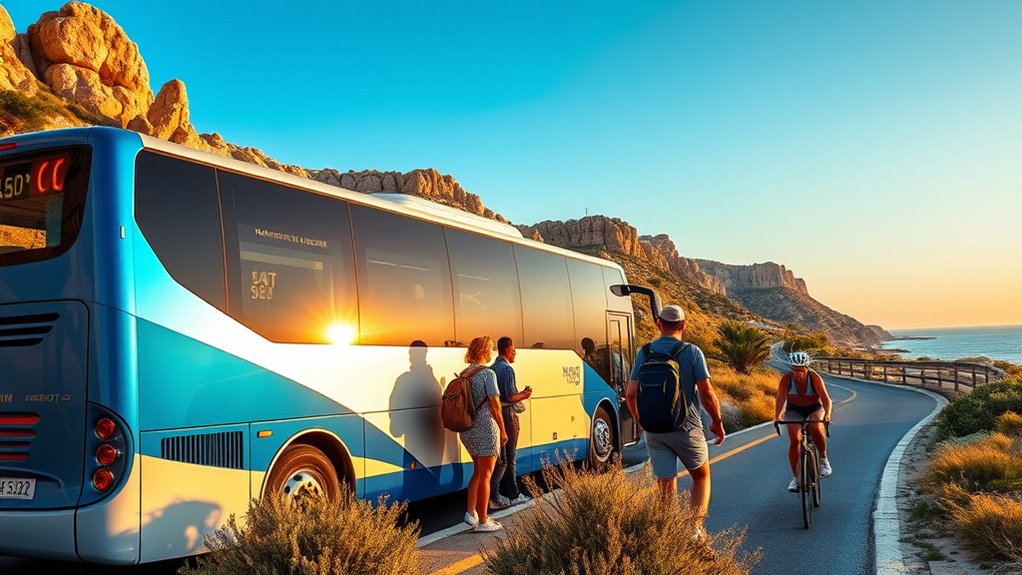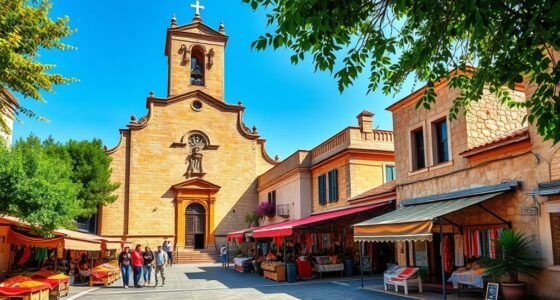Getting around Sardinia by public transport is easy and budget-friendly, with trains connecting major cities like Cagliari, Sassari, and Olbia, and buses covering towns and remote villages. Seasonal scenic routes and tourist trains add a memorable touch to your trip. However, outside urban areas, schedules can be limited or irregular. For more tips on planning, tickets, and routes, you’ll find helpful insights to make your journey smooth and enjoyable.
Key Takeaways
- Sardinia offers a comprehensive public transport system with trains, buses, and scenic tourist routes connecting major cities and remote areas.
- Use the Trenitalia and ARST networks for affordable, scheduled travel between towns, villages, and scenic destinations across the island.
- Real-time schedules and tickets can be managed via mobile apps like Moovit, “Around Sardinia,” or “Orari bus Sardinia.”
- Rural and interior regions may have limited or infrequent services, requiring careful planning and consideration of transfer times.
- For greater flexibility and access to remote attractions, renting a car remains a practical option alongside public transport.
Overview of Sardinian Public Transport Systems

Sardinia’s public transport system offers a mix of railway and bus services that help you navigate the island’s diverse terrain. The railway network spans about 1,038 km, combining mainline routes managed by Trenitalia and narrower lines operated by ARST. Trenitalia connects major cities like Cagliari, Sassari, Olbia, and Porto Torres with frequent, affordable trains, often under €20 for long journeys. Stations are usually centrally located, making city access easy. ARST manages narrow-gauge lines serving less accessible areas, such as Sassari to Alghero, and scenic tourist routes like the “Trenino Verde.” While some lines have closed in the past, current coverage reaches all provinces, with a well-coordinated network of rail and bus services designed to suit both local travel and tourism needs. Additionally, the rolling stock quality and modernized infrastructure contribute significantly to a comfortable travel experience across the island.
Navigating the Bus Network and Ticketing Options

The bus network operated by ARST provides a practical way to explore Sardinia’s diverse landscapes, from bustling cities to remote villages. With over 312 routes and 3,470 stops, it connects major towns like Cagliari, Sassari, and Olbia, as well as isolated areas. Bus schedules are available in real time via the Moovit app, so you can plan your trips accurately. Many routes run several times daily, but service can be irregular in less-populated regions, especially during off-peak hours. Tickets are versatile—you can buy them on the bus with cash, in advance, or through mobile apps. Prices are generally affordable, and remember to validate your ticket before boarding to avoid penalties. Keep an eye on route updates for a smooth journey. Additionally, ARST operates 312 bus routes across Sardinia, ensuring comprehensive coverage of the island’s diverse terrain. Utilizing public transport information systems can help travelers stay informed about schedule changes and route disruptions.
Rail Services: Connecting Key Cities and Scenic Routes

Trenitalia operates the island’s main standard-gauge railway network, connecting key cities and ferry terminals for convenient travel across Sardinia. You can travel from Cagliari to Olbia via Oristano, Macomer, and Ozieri-Chilivani, with departures every hour or two. Other routes link Cagliari north to Sassari and Porto Torres, and west to Iglesias and Carbonia. Ticket prices are affordable—less than €20 for long journeys like Cagliari to Olbia. Ozieri-Chilivani serves as a major junction, enabling easy transfers between routes. ARST complements Trenitalia by serving smaller towns and coastal destinations with narrow-gauge trains. While Trenitalia offers reliable daytime services, scenic routes like Trenino Verde provide slow, picturesque journeys through Sardinia’s interior, perfect for sightseeing. Rail services are generally punctual and well-maintained, making train travel a reliable option for exploring the island. Additionally, passenger comfort is prioritized on many trains, ensuring a pleasant journey for travelers.
Seasonal Tourist Trains and Their Unique Offerings

During certain seasons, Sardinia offers scenic rural routes on charming tourist trains that let you experience the island’s natural beauty at a relaxed pace. These journeys operate on seasonal schedules, often taking you through forests, gorges, and valleys away from crowded areas. Traveling slowly and nostalgically, you’ll enjoy immersive sightseeing and unique stops that showcase local culture and wildlife. To enhance your experience, some routes include community support features, which provide helpful information and foster a connection with fellow travelers.
Scenic Rural Routes
Exploring Sardinia’s interior becomes an unforgettable experience when you hop aboard the seasonal tourist trains of Trenino Verde, which wind through the island’s rugged mountains and lush landscapes. These four main routes cover 404 km of narrow-gauge rail during summer, offering diverse scenery. The Mandas–Arbatax route spans 159 km over 5 hours, crossing tunnels and bridges through Ogliastra’s green mountains, reaching 868 meters elevation. The Isili–Sorgono route, about 83 km long, passes quiet villages and ends near Golfo di Orosei. Other routes like Mandas–Seui and Arbatax–Gairo highlight Sardinia’s natural beauty and cultural sites, including Nuragic ruins and petrified forests. Traveling these historic tracks, you enjoy stunning vistas, historic stations, and a vintage ambiance that immerses you in the island’s rural charm. The routes feature countless turns over a 125-year-old railway, adding to the nostalgic and scenic experience. These journeys also demonstrate how effective time management can enhance travel experiences by allowing for better planning and exploration of such scenic routes.
Seasonal Operation Schedules
Seasonal operation schedules for Sardinia’s tourist trains guarantee visitors can experience the island’s stunning landscapes at the right time of year. During summer, the Little Green Train runs daily from mid-June to mid-September, offering scenic rides minus Tuesdays. Several tourist lines, like Isili-Arise and Macomer-Bosa, operate seasonally, showcasing Sardinia’s diverse beauty. Special events and group rides add exclusive experiences, while some routes are temporarily closed for renovations. Imagine passing through lush valleys, ancient archaeological sites, or sparkling beaches, all during the peak season. The island’s rail network adapts to seasonal demand, ensuring travelers can enjoy the most picturesque routes when the scenery is at its most vibrant. Feel the warmth of Sardinian sun as you traverse scenic routes. Discover hidden cultural gems on guided tours. Savor traditional lunches at charming stopovers. Experience the thrill of riding historic trains through timeless landscapes, where seasonal schedules are carefully planned to maximize tourism benefits.
Slow, Nostalgic Travel
Sardinia’s scenic train routes offer a charming alternative to the island’s busy summer schedules, inviting you to experience the landscape at a gentle, unhurried pace. The Trenino Verde uses vintage coaches on narrow gauge lines through remote, natural landscapes—cliffs, gorges, forests, and valleys. These routes highlight Sardinia’s rugged beauty, with opportunities to see wildlife like mouflon and wild boars. Some journeys include ferry rides, ceramics workshops, and museum visits, enriching your cultural immersion. Traveling on these nostalgic trains, you’ll feel transported to a bygone era, slow-paced and intimate with the land. This experience not only preserves Sardinian heritage but also supports local communities, offering a mindful escape into nature and history. By choosing sustainable travel options, visitors can enjoy these scenic journeys while minimizing their environmental impact.
Limitations and Challenges of Public Transport on the Island

You’ll find that outside the main cities, public transport coverage is quite limited, making it hard to reach many interior areas. Buses run infrequently and on irregular schedules, which can leave you waiting longer than expected. These gaps often force travelers to rely on private transport, adding to the island’s travel challenges. Additionally, the lack of consistent and comprehensive public transport options can make planning trips more complicated for visitors.
Limited Coverage Outside Cities
Public transport on the island faces significant challenges outside urban areas due to rugged terrain, low population density, and fragmented service networks. Many rural and interior zones lack frequent or reliable bus and train services, creating “transport deserts” that limit mobility for residents. Private operators offer some Rent for Driving services, but they’re small-scale and don’t fill the coverage gaps. Small villages often have limited or no service, leaving residents dependent on private vehicles. The disjointed network and lack of coordination among multiple operators hinder route continuity. This patchwork of services deepens social exclusion, restricts access to economic opportunities, and increases car dependency. Furthermore, the limited investment in infrastructure and service expansion hampers efforts to improve accessibility. – Isolated communities struggle with limited access. – Long distances make travel inconvenient. – Dependence on private vehicles grows. – Limited investment hampers expansion. Additionally, service fragmentation complicates efforts to establish a more cohesive and reliable transportation system, further isolating remote areas.
Infrequent and Irregular Schedules
Despite the island’s scenic landscapes, the public transport system struggles with infrequent and irregular schedules that hinder reliable travel. Buses often run just a few times daily, mostly during peak hours, limiting your flexibility. Outside summer, schedules can be unpredictable, with some routes operating sporadically or not at all on weekends and holidays. Night services are minimal or nonexistent, restricting late-night options. Timetables are often uncoordinated, causing long waits and transfer delays. Changes to schedules happen quietly, confusing travelers. Many routes, especially in rural areas, run seasonally or only on specific days, making consistent planning difficult. This irregularity results in longer travel times, discourages use, and pushes residents and visitors toward private cars. Despite efforts like expanding urban transit, regional gaps remain a challenge. The lack of integrated scheduling systems further exacerbates these issues, making it difficult for travelers to plan their journeys effectively. Additionally, public transportation planning often does not account for seasonal and regional variations, compounding the problem.
Practical Tips for Planning Your Public Transit Journeys

Planning your public transit journeys in Sardinia requires checking schedules in advance and staying flexible, as services can vary by season and location. To make the most of your trip, confirm departure times online, but don’t hesitate to ask station staff for real-time info—they often know best. Always validate your tickets onboard buses or at machines in stations, or risk fines. Use main city stations for intercity departures to find schedules and assistance easily. For scenic or seasonal routes like Trenino Verde, check online regularly due to limited operation and possible delays. Remember, public transport covers key cities and some towns, but rural and remote sites may require planning for long waits or transfers. Sardinia’s public transport system is continuously evolving, with new routes and schedules added periodically to improve connectivity.
- Feel confident in your plans by confirming schedules daily.
- Rely on station staff for the most accurate info.
- Prepare for potential long waits in remote areas.
- Keep your tickets validated to avoid fines.
Comparing Public Transport With Car Rental for Flexibility

When choosing how to explore Sardinia, weighing the pros and cons of public transport versus car rental can make a big difference in your trip’s flexibility. Public transport is budget-friendly and eco-conscious, but it’s limited in coverage and schedule, especially in remote areas. Buses mainly serve major towns, making spontaneous trips or visits to off-the-beaten-path sites challenging. Car rental offers unparalleled freedom—you can visit secluded beaches, mountains, and archaeological sites on your own timetable. It’s more convenient for carrying luggage and traveling in groups, but comes with costs like fuel, parking, and insurance. While public transport minimizes expenses and environmental impact, renting a car provides the flexibility and comfort needed to explore Sardinia’s diverse landscapes without restrictions. In fact, the island’s extensive winding coastal roads and scenic mountain routes are best enjoyed with a car, giving you access to hidden gems that public transit cannot reach.
Tips for Using Digital Tools and Local Assistance

Using digital tools and seeking local assistance can considerably enhance your experience traversing Sardinia’s public transport. Download apps like “Around Sardinia” for digital tickets that are easy to store and validate onboard, saving time and hassle. The “Orari bus Sardinia” app offers real-time schedules, route info, and timetable updates, helping you plan your trips confidently. Bluetooth validation technology streamlines boarding, reducing wait times, while local staff at transport hubs and tourist info centers are always ready to help with directions, schedules, or last-minute questions. Printed maps and schedules remain available for offline reference when needed. Regional transit apps are also useful for accessing comprehensive service information and updates specific to Sardinia.
- Feel confident navigating unfamiliar routes with real-time updates.
- Save time with quick, contactless validation onboard.
- Find helpful staff and info points when in doubt.
- Travel smoothly, knowing assistance is nearby.
Recommendations for Exploring Sardinia Efficiently

To explore Sardinia efficiently, taking advantage of its public transport network is key, but it requires some strategic planning. Use ARST buses for intercity travel between major towns like Cagliari, Sassari, and Olbia, and check schedules online or at stations, as they vary in frequency. Combine bus and train routes at key interchange points such as Sassari and Macomer, but be prepared for walking between separate stations. For scenic journeys, consider the Trenino Verde tourist trains, mainly in summer, for leisurely exploration of mountainous areas. To maximize your time, prioritize routes with frequent service and plan transfers carefully, especially in rural regions where connections are less reliable.
| Route Type | Key Tips |
|---|---|
| Buses (ARST) | Check schedules early; buy tickets online |
| Trains (Trenitalia) | Use for main city-to-city travel |
| Tourist Trains | Ideal for scenic, leisurely trips |
| Interchange Points | Plan transfers; walk between stations |
Frequently Asked Questions
Are There Any Night Bus Services Available in Sardinia?
You’re wondering if night bus services operate in Sardinia. Most public transport in Sardinia, including ARST buses, mainly runs during the day with limited or no dedicated night services. Some routes have late evening departures, but overnight buses are rare or nonexistent outside tourist seasons and big cities. For late-night travel, taxis or private transfers are your best options, as public buses aren’t reliable for nighttime trips.
How Reliable Are the Seasonal Tourist Trains During Peak Season?
During peak season, seasonal tourist trains like Trenino Verde run only a few times daily, making them quite unreliable. You’ll find that these trains often face delays, interruptions, and limited schedules, especially in summer months. With many trains over 20 years old and infrastructure issues, expect slow speeds and occasional shutdowns. If you’re counting on consistent transport, these trains might not meet your expectations during Sardinia’s busy tourist season.
Can I Buy Combined Bus and Train Tickets for Easier Travel?
You can’t buy combined bus and train tickets directly for easier travel in Sardinia. You’ll need to purchase your train tickets from Trenitalia and bus tickets from ARST separately. There’s no widespread, integrated ticketing system for local routes on the island. To make travel smoother, plan your routes carefully, buy tickets in advance, and use mobile apps for both systems, but be prepared to handle each mode independently.
Are There Accessible Public Transport Options for Travelers With Disabilities?
You’ll find plenty of accessible options for public transport in Sardinia. Trenitalia’s rail services include stations with special accommodations and free assistance through Sala Blu, making train travel easier. Buses by ARST have accessible seating and lifts, but you’ll need to give advance notice. City trams feature wheelchair-friendly platforms, and ferries and airports offer accessible routes and services. Overall, Sardinia’s public transport is designed to help travelers with disabilities move comfortably.
What Are the Best Strategies for Avoiding Long Waits Between Transfers?
Waiting between transfers can feel like an eternity, but with the right strategy, you can make it fly by. You should always check schedules in advance using online tools or apps, aiming to sync your connections perfectly. Avoid peak hours, plan for buffer time, and seek advice from station staff if needed. Staying flexible and prepared guarantees you won’t be stuck counting seconds, turning long waits into quick, manageable gaps.
Conclusion
By blending bus, boat, and rail routes, you can comfortably conquer Sardinia’s stunning scenery and vibrant villages. Embrace the ease of efficient, economical travel options, and equip yourself with digital tools and local tips. With a little planning and a willingness to explore, you’ll unleash unforgettable adventures across the island. Sardinia’s scenic splendors are just a ride away—so seize the service, step out confidently, and savor every scenic stretch!









